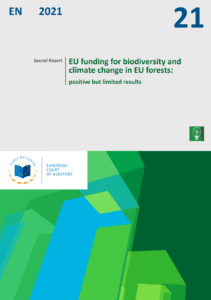The European Court of Auditors (ECA) released their analysis of the EU funding for biodiversity and climate change in EU forests for the period 2014-2020 (related to the last EU Forest Strategy). They conclude that the EU has had a positive but limited impact on protecting biodiversity and addressing climate change in EU forests.
A first observation is that, while forests cover a similar area to agriculture, funding for forested areas from the EU budget is much lower than for agriculture (less than 1% of the CAP budget). Moreover, the funding is focused on support for conservation measures and planting and restoring woodland. According to the ECA, 90% of the EU’s forestry financing is channeled through the European Agricultural Fund for Rural Development (EAFRD).
The 4 main findings of the report are:
- The EU approved the Habitats and Birds Directives and the Commission has adopted several strategies to address the poor biodiversity and conservation status of EU forests. But the quality of the conservation measures for these forest habitats covered by the Directives continues to be problematic.
- The Timber Regulation aims to stop illegal logging in the EU. The report explains that the Commission has not assessed the quality of Member State checks. While remote sensing offers a great potential for cost-effective monitoring over large areas, the Commission does not use it consistently.
- The EU is increasingly addressing forests in its climate change policies. Climate change concerns in forests feature in both the Renewable Energy Directive and the LULUCF Regulation. However, issues such as adapting forests to climate change and setting ecological boundaries on the use of forests for energy are less well developed. Efforts to improve the focus of woodland climate adaptation strategies have been hampered by a lack of knowledge and information.
- The EU channels financial support to forestry-related climate change and biodiversity actions mainly through the EAFRD. The report shows that, overall, the EAFRD rules and procedures do not guarantee greater biodiversity and resilience to climate change. The legislative proposals for the post-2020 CAP give Member States more flexibility in the design of forestry support schemes and do not address these weaknesses. The common EU monitoring system does not measure the biodiversity and climate change effects of forestry measures.
“The most interesting aspect of the conclusions of the Court of Auditors is that while the European Commission is increasingly addressing forests in its climate change policies, the support to sustainable forest management is not reflecting this. In particular, more funding is needed to the research and innovation activities outlined in the FTP Strategic Research and Innovation Agenda 2030”, explains Johan Elvnert, Secretary General of FTP.
In the report, the auditors recommend to:
- improve the EU’s contribution to biodiversity and how to better tackle climate change in EU forests;
- strengthen the fight against illegal logging; and
- improve the focus of rural development forestry measures on biodiversity and climate change.
The report is available in English and 22 other languages at this page.


